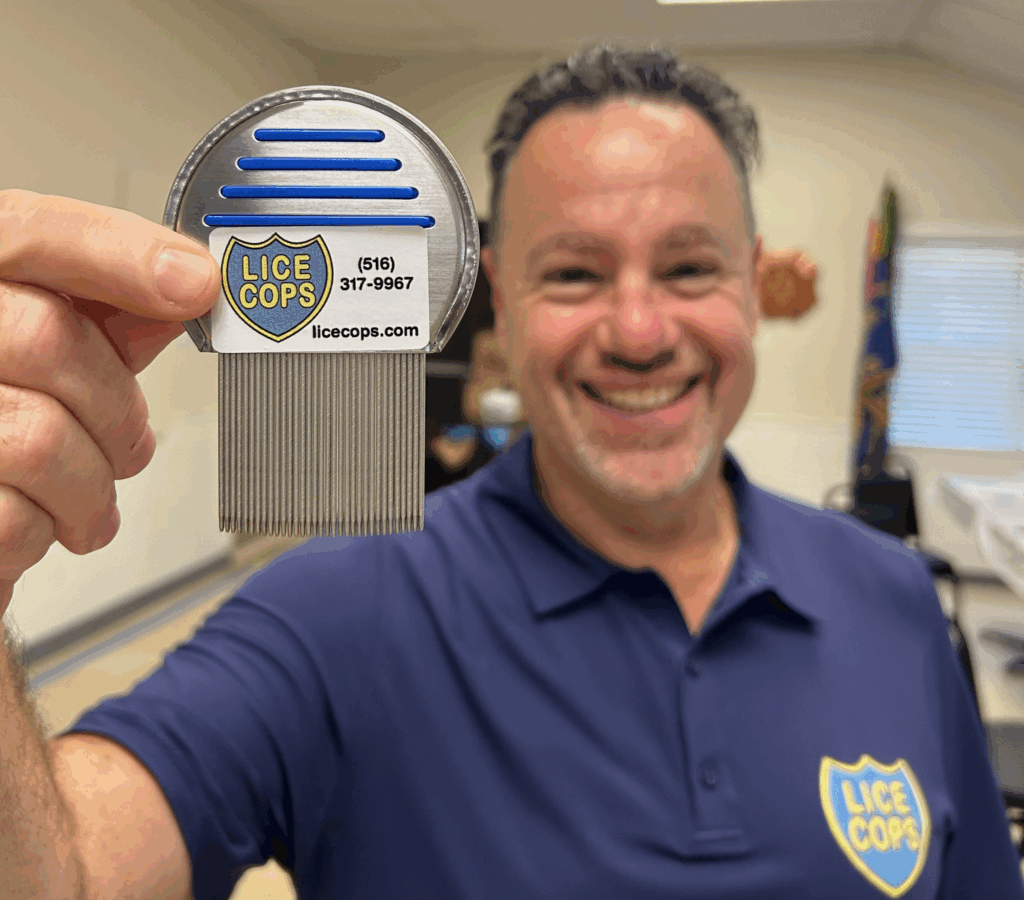Did you know that each year, approximately 12 million people in the United States are afflicted with lice? Lice have been around for thousands of years, even found on the heads of ancient mummies. A nuisance spanning generations of people with hair, these pests have a life cycle of 30 days, but left untreated, will continue to reproduce and cause a maddening itch. We connected with Russ Trichon of Lice Cops to get his take on everything you need to know about lice. Hear it from Russ himself!
About Lice
Lice are wingless insects that live on the hair of humans and feed on very small amounts of blood from our scalp. The lice cannot jump, but they can crawl from head to head, either by touching heads, sharing tools like hair brushes and combs, or possibly by laying on someone else’s pillow if a louse (singular form of lice) is crawling on it.
If I was playing Family Feud and the question was “how do we get lice” the top answer would be hugging because heads often touch during a hug! The second most common answer is selfies with other people, because heads tend to touch then, too. I especially see this from kids at school and summer camp. They may not be sharing brushes, but there sure are a lot of hugs and selfies going around! The origin story of every lice meet-cute is all about people with hair meeting other people with hair.
“Lice can affect anyone with hair. It does not discriminate by age, race, religion, or gender.“
Lice eggs, called nits, do not fall out – the only way for a nit to fall out is if you pluck the actual hair on it. This is because the eggs have a glue-like sheath that attaches to the hair at about ¼ – ½” from the scalp. Nits have a cap called the operculum, which is like a lid on a metal trash can.
Lice can affect anyone with hair. It does not discriminate by age, race, religion, or gender. However, lice is typically more common in girls, because they traditionally have long hair, and girls hug a lot more than boys. The long hair itself is not attractive to lice, but there’s more opportunity for it to latch on to a strand when heads are touching.
The Lice Removal Process
First thing’s first – I like to calm people down during the process and talk them off the proverbial ledge, then handle the situation which luckily is a straightforward solution. A lot of people come to me very worried about their situation and I tell them this: there are things in this world that are fixable and there are things in this world that are not fixable. Lice is fixable!
A lot of people hear wrong information from family and friends and that is what brings them closer to the ledge. My job is to give them the facts and a lot of people are surprised when I don’t come with gloves or a hazmat suit because they’re thinking the worst. I like to remind them that houses do not get infested, only people get infested. More on that later.
The best way to get rid of lice is to manually remove them with a tight tooth lice comb. There are cheap versions which don’t work as well, and good versions. A good lice comb is made of strong, stainless steel with tight teeth.
At Lice Cops, I am certified in a method called the Shepherd Method, a method developed by Katie Shepherd (my hero!). This is a strand-by-strand technique that does not use chemicals nor pesticide shampoos. Lice have become more resistant to these pesticides, which is why this method is the preference of our team. Years ago, shampoos worked pretty well but we have begun to see the resistance in the form of super lice, which are increasingly unresponsive to the shampoo method. The over-the-counter products are designed to kill lice on contact, but I physically take them out. Another thing to consider is that the shampoos are not effective on nits, which use that glue-like sheath to adhere to the hair. My school of thought is that the only way to beat the bug (and their eggs) out is take them out physically.

With the Shepherd Method, one treatment is usually all it takes, but I will always encourage a re-check. Although the treatments are highly effective, it is always possible for a residual nit or a baby louse to remain as part of the natural lifecycle of lice. One single louse or nit does not worry me because if they have no opportunity to reproduce, they die in about 30 days, but they may still cause an itch. Post-treatment combing, preventative sprays, and follow ups are encouraged to keep heads lice-free. It is important to remember that overcoming a case of lice is not the same as overcoming a viral illness. You cannot become immune to lice after you’ve had lice. All these things are important to think about, because you may have gotten lice from someone you’re close with, and if they don’t get checked, they may not know that they have it and can give it back to you. This highlights the importance of transparency, quick treatment, and having no shame in a lice diagnosis! The more we know, the better we can do to fight it together.
“It is important to remember that overcoming a case of lice is not the same as overcoming a viral illness. You cannot become immune to lice after you’ve had lice.“
After I give kids a treatment, I let them know that they can go back to school right away. I like to teach the parents to always follow up with the comb, use preventative sprays to reduce the possibility of reinfestation, and monitor their child for itchiness.
Lice Symptoms and How to Spot Them
Once a school sends home a notice about lice in the classroom, I am often asked by parents how to even know if a child has lice. Scalp itchiness is usually the identifying factor. If you see a little bit of redness on the nape of the neck or behind the ears, that can also be an indication of a louse bite. You can also sometimes see the lice on your child’s head. It’s better to use a good lice comb to really tell if what you’re looking at is lice.
Lice have 6 legs and adults can be seen moving with the naked eye. Babies can also be seen but are a lot smaller. Adults can be as large as the size of a sesame seed. Nits will be smaller, found within an inch from the scalp. Picture how a tiny bead of water would look on a strand of hair – that’s almost how an egg would look. It will be on one side of the strand, not wrapped around. If you run your fingers over the strand of hair and feel what is like a speedbump, it’s probably a nit. Remember that nits have a glue-like sheath that adheres them to a hair strand. If it flakes, then it’s just a dandruff flake. As I tell my clients, a flake’s gonna flake (cue Taylor Swift’s “Shake It Off”).
If you’re suspicious of possible lice, look at the scalp up to the first inch or two of hair. Because lice live off human blood, they will be found closer to their food source – the scalp. I am often asked if people should cut their long hair to reduce or prevent future lice, to which I say no. Because lice like to live in the first few inches of your hair from your scalp, cutting hair will not be effective and it will probably make you unhappy. Unless you’re excited about the prospect of a new haircut, in which case I say: do what makes you happy!
Lice Prevention Tips for Families
After someone has been treated for lice, I am often asked about lice living in the house. Since lice are topical creatures only, they will not burrow into mattresses, pillows, or cushions. I am a fan of a vacuum cleaner, which is sufficient for getting rid of possible bugs that could have fallen off hair and on to pillows, mattresses, cushions, clothes, you name it. Whatever you decide put in the washing machine will most likely be eliminated of lice, but a word of caution: as you are transferring things from the wash to the dryer, a single louse could still be alive in there, so be sure to use high heat in the dryer to be sure you’ve killed any remaining bugs. The water temperature does not matter, but the intensity of heat in the dryer will make a difference!
If you can’t put something through the dryer, be sure to separate it from everything else for a few days. A lot of people think they can “suffocate” lice and put everything in a tightened contractor bag. There’s nothing wrong about doing that, but the reality is that lice aren’t suffocated – they’re starved. Remember that lice thrive on human blood so when you have removed their food source, they starve to death in a matter of 2-3 days. You also don’t need to fumigate your home.
Lice don’t like the smell of rosemary, tea tree, or peppermint because of their strong fragrance, but many people find them quite pleasant. I am personally a fan of rosemary. There is not enough rosemary in the world to get rid of lice altogether, but because they do not like the scent, spraying in the hair prior will reduce the odds. While I think the sprays are effective, just because you have spray in your hair doesn’t mean you will never get lice. During the summertime, the sprays are less effective because kids are sweating and swimming more, which dilutes or takes the spray out. Tea tree oil and peppermint can be effective, but I personally don’t like them as much because it often gives a burning sensation to the scalp. But you’ve got choices!
If you have a friend that has lice, do not be unkind to them. Remember, lice isn’t a reflection of cleanliness or character – it’s simply a bug that anyone with hair can encounter. With the right knowledge, tools, and a little compassion, let’s remember that lice is not a crisis, it’s a problem with a solution.
About the Author

Russ Trichon is a lice removal expert and the owner of Lice Cops. Mr. Trichon was trained by head lice expert, Katie Shepherd, and has been certified through The Shepherd Institute. Lice Cops provides a kid-friendly approach, with a goal to serve, protect, and educate. Learn more about Russ Trichon and Lice Cops at licecops.com
